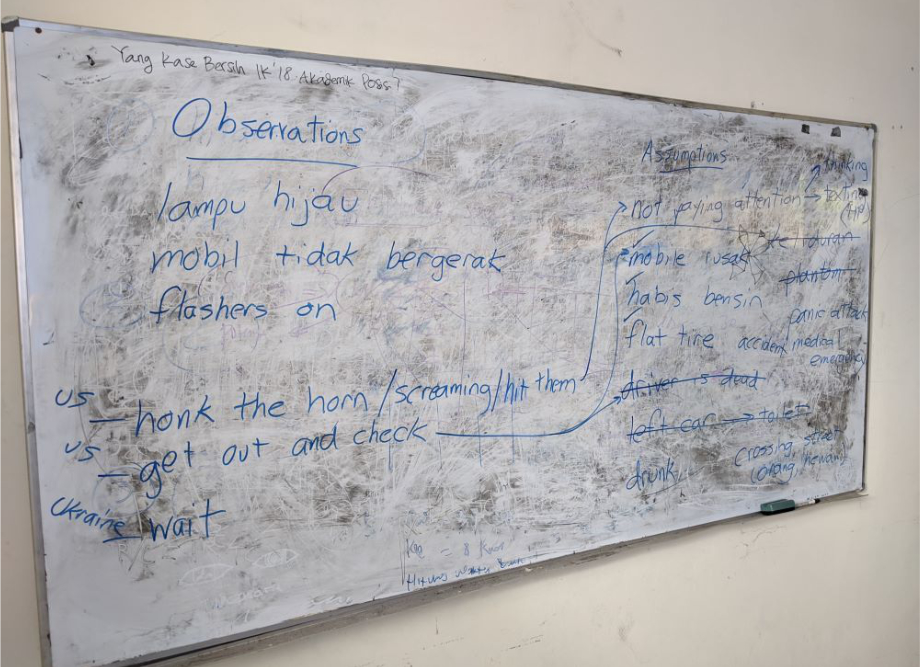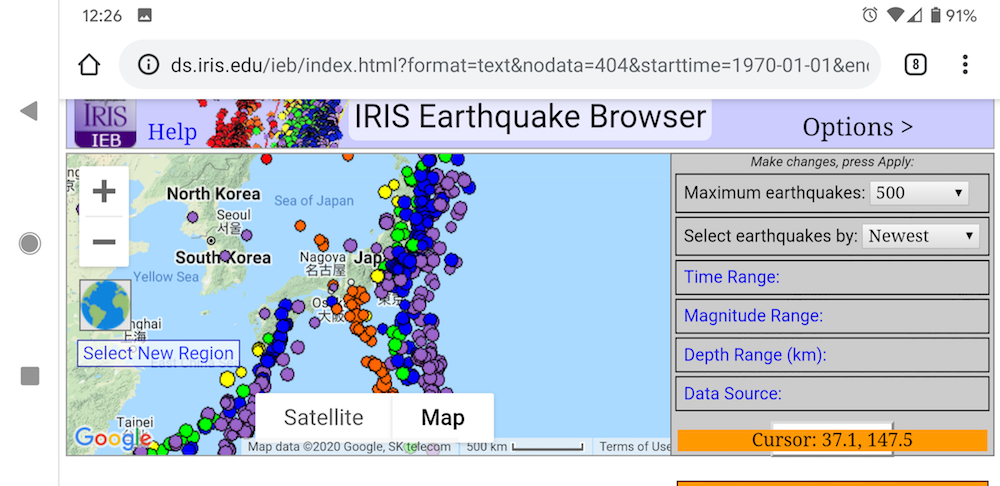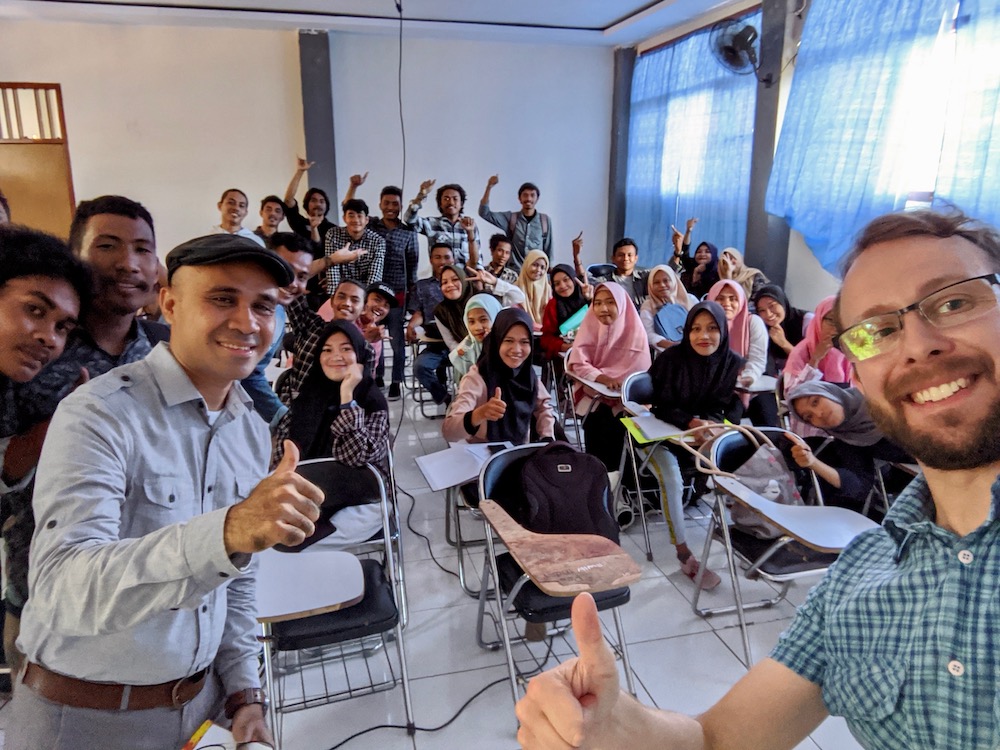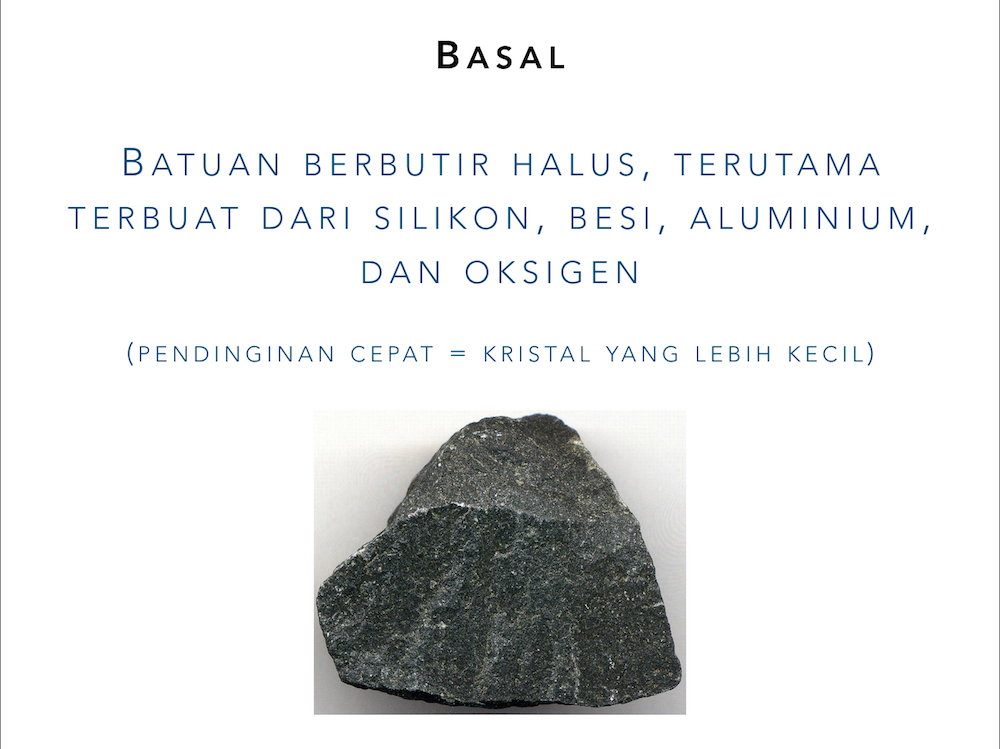Eastern Indonesian Classroom Experience
I discovered I would be teaching my first class at Khairun University about twenty minutes after it started. “Sometimes the teachers just don’t show up,” my host, Dr. Halikuddin Umasangaji told me with some annoyance. It’s something the university was working on. But that did not help me the first day of my Marine Geology class. I had expected something like this, so I had activities from classes I had previously taught that I could utilize on day one. Unfortunately, they were all in English. I was told that this was fine, but since science is often about very precise communication, I would have felt better if I had had a chance to prepare a proper Indonesian translation.
Although I didn’t have a lot of time to prepare (mere seconds, as it turned out), I found my experiences in online and offline American classrooms, particularly when technology horribly misfires, prepared me well for adjusting to new classroom settings and unexpected developments. Because I was working in eastern Indonesia in a university setting that didn’t typically see a lot of funding, the classroom facilities were limited. The classroom I worked in had desks for dozens of students, a desk in front for the teacher, a projector that showed almost all the colors, and what at some point had been a white whiteboard. Fans and the island breeze kept the air circulating in the classroom, but it also meant that the curtains were blowing into students’ faces and the only way to cope was to tie the curtains open, making the projected content much less visible.
Still, the facilities are less important than the class atmosphere. I was hoping to observe a typical Indonesian classroom to calibrate my expectations, but didn’t have the chance due to the short length of my stay in Indonesia. Halik and other lecturers told me that active learning is not typical and that Indonesian college classrooms tend to be overwhelmingly passive learning environments, with a lecturer presenting a significant amount of material to students via slides. Without previous experience in active learning, it is often difficult for students to adjust to a format that requires active participation, and without good examples of active learning in practice, it is difficult for teachers to redesign their courses into an active learning format. I ran into both challenges via the classroom and the professional development sequence I was running for the faculty.
Passive and active learning have their challenges when working in a multi-lingual classroom. Since I wasn’t actually prepared to teach the first day I was teaching, all my slides were in English, and they included a lot of technical language. This resulted in a significant slowdown as Halik, who was acting as my translator, needed to read the slide, ask me clarifying questions, translate for students, answer their clarifying questions, and then sometimes translate those questions for me to answer. A lesson that took me about 2 hours in the US took double the time in Indonesia. Since the class only met for two hours a week, my “introduction to science” lesson ended up taking two weeks. Halik mentioned that if I wanted, we could just call the students in on Friday or Saturday to teach them more, which was apparently a fine thing to do. However, I needed prep time, so I deferred on that option until I felt it would be truly necessary.
The active learning component of the class worked better, but it took students a while to get used to the idea that I expected them to answer my questions and to discuss ideas with each other. However, I also noticed that the class came alive during those portions. In one lesson that I typically do on the philosophy of science, I use a “stopped car” example to illustrate how our hypotheses change as our observations change. At first, students were hesitant to offer ideas for why a stopped car at a traffic light might not be moving. But once a student volunteered that the driver may have died, to much laughter from the class and then surprise when I said it was a viable hypothesis, the creativity, discussion, and ideas started to flow.

Working through the stopped car thought experiment, with a mix of Indonesian and English. Observations include a green light (lampu hijau), the car in front of you not moving (mobil tidak bergerak), and flashers on. Students proposed many reasons for these observations, including that the driver is not paying attention, the car is broken (mobil rusak), lack of gas (habis bensin), flat tires, driver is dead, driver fell asleep (ketiduran), there has been a panic attack or medical emergency, or that people (orang) or animals (hewan) are crossing the street.
That first experience helped shape the approach I took in subsequent weeks. After the introductory material was complete and I got a basic feel for how the students and I interacted, I could start thinking about the science content I wanted to teach. Internet connectivity in the classroom was poor and students were mostly equipped with smartphones. I had to pre-test a lot of the digital activities I wanted to do on my phone, which was usually the only internet connection I had anyway (as long as I prepaid for enough quota). I found that I had to ditch a lot of ideas because they simply weren’t feasible in that kind of technological environment. Some of my favorite digital teaching resources were old and hadn’t been updated in a decade, and so weren’t very usable by smartphone. Others just wouldn’t load at the available bandwidth speeds. Since bandwidth needed to be prepaid by the gigabyte, I also needed to be cognizant of how much bandwidth a chosen tool would require, as not all my students could afford the quota costs. Once I accounted for all of these limitations, the library of quality interactive teaching content became shockingly slim.

The IRIS Earthquake Browser, a fantastic teaching tool for doing basic investigations of global earthquake patterns. It was usable in some smartphone environments (pictured here a screenshot from my Pixel 3a), but not all. Because the tool was built before smartphones were ubiquitous (I started using it in 2010 and it has remained essentially unchanged), some features were not very smartphone friendly.
To assist my students with the content, since few had command of the English language, I took the time to translate each of my slides into Indonesian. Since I was working with slides that I had from other courses, it was a fairly simple matter to create Indonesian translations, especially since my slides tend towards images and important definitions and not much more. I worked via Google Translate and my intermediate-level command of the Indonesian language to refine the word choice of translations that I found questionable. Wherever I could, I would have the Indonesian translations next to the English versions so that students could work on their technical English skills while getting important definitions in a more familiar language.
Slide with English definition, followed by Indonesian definition (which required refinement) – Slide with only Indonesian text (English-language slide preceded it) – Slide with English and Indonesian together.
A key component to success, however, was working closely with Halik to prepare for each class. After I determined the flow of the class activities and completed the supporting slides, we met up on Sunday nights to review the material. He wanted to understand what he was translating, as some of the material was outside his areas of experience. I wanted him to review my translations to ensure that the words I had chosen for some of the technical language were correct, as the results from Google Translate, although a good starting point, tended towards using colloquial synonyms rather than a more appropriate technical word. Reviewing the material beforehand also helped alleviate his curiosity because on a number of occasions in the first few weeks, he tended to answer my questions because he was interested in the topic, instead of translating the questions for the students to answer.
The most challenging problem, and the one I was most interested in exploring (hence my choice of assignment location), was how well these concepts would translate across a significant cultural boundary. I was surprised to see how quickly my most useful analogies fell apart and at my inability to find a relevant local example because I had not yet spent enough time on location. For example, my go-to analogy for teaching about the scientific process is the stopped car example, which works extremely well in US classes (and worked fairly well in Ukraine as well, with slightly different outcomes). On an island with few cars and traffic rules that technically existed but were opaque to me, I had a lot of difficulty adapting the example to be relevant. Should I switch to motorbikes, which were much more common? How do people typically signal they have a problem with their vehicle? Do they also use the hazard lights here? Does the example still work if you have a motorbike where you can see the rider, compared to a car where you may not? We muddled through the example as best we could, but it felt less effective since I didn’t quite yet understand the cultural context. My distances-in-space example, where I use everyday transport modes (usually a car traveling at 65 miles per hour from Phoenix to Los Angeles) to shock students with how long a journey at those speeds takes to various solar system bodies, likewise suffered problems, as using the typical island motorbike speed took a journey to Mars (about 60 years at 65 mph) and made it unimaginable (1000 years at typical island motorbike speeds). I switched the example speed to an airplane, but how many of my students had been on an airplane before? Would a boat example be better to use instead? And if so, what kind of boat? A ferry? A motorboat? How did people move from island to island? I hadn’t personally visited another island yet, so I didn’t know what was most typical and couldn’t choose a relevant maritime example.
Because of the pandemic and subsequent cancellation of the Fulbright program, I was never fully able to slip into the local environment and start to learn the culture well enough to create relevant local examples for the content I was teaching. Still, my incredibly limited teaching experience (3 classes for students and 5 professional development seminars for faculty) challenged me in ways that I was both prepared and unprepared for. The parts that I was unprepared for were a wealth of learning opportunities, even if they were more limited than I had anticipated.

Halik and me with the Marine Geology class. This was followed by about 30 minutes of selfies.
Notes for Practice
Multi-Lingual and Cross-Cultural Classrooms
Learn the language. Having a working knowledge of basic words, such as colors, numbers, and shapes, helps you communicate with students and them with you for simple tasks like interpreting graphs or observations without having to go through a translator.
Take the time to translate slide materials. Presenting information in both English and the primary language of the students gives students practice with English while also providing important content without information loss due to poor automated translations. Google Translate is great as a starting point, but all text should be reviewed by a fluent speaker since technical terms often aren’t translated correctly.
Review materials with your translator ahead of time. Science often requires precise communication and even if you have a correct conceptualization of the concept, your translator may not and may introduce misconceptions during the translation process.
Reduce the amount of content covered. In-class translation increases the amount of time activities, lectures, and questions take considerably. For a two-hour class, limit to one active learning activity and the concepts that branch off of it.
Mobile-friendly content. In many global classrooms, internet bandwidth is limited and students may be limited to smartphones. Find and test resources on smartphones ahead of time. When developing new digital content for educational purposes, consider swapping flashiness for efficiency (bandwidth and memory usage) so that your applications and websites are not chewing through bandwidth and battery power. Consider also clever usage of smartphone capabilities that expand beyond using the phone as merely a portal to videos, images, and written text.



